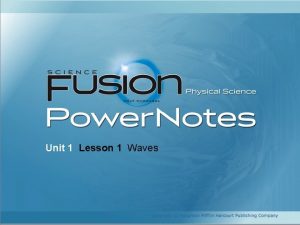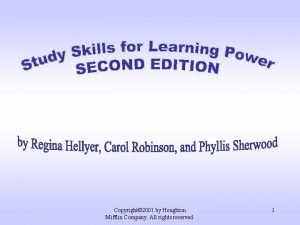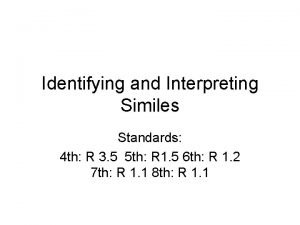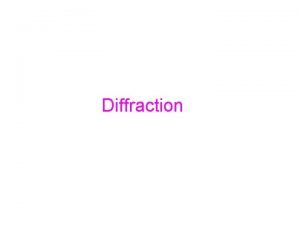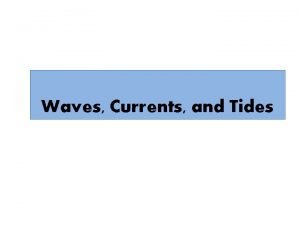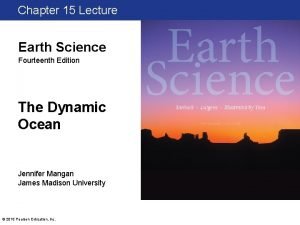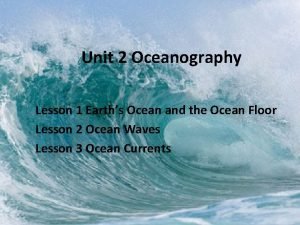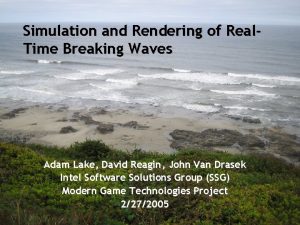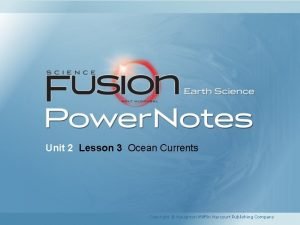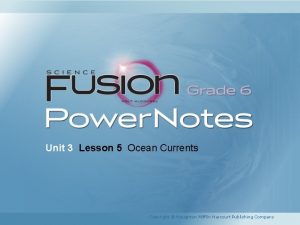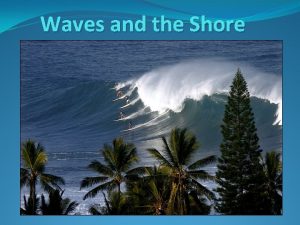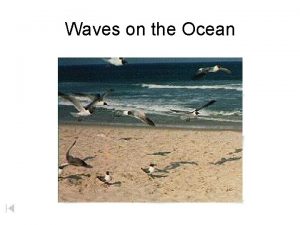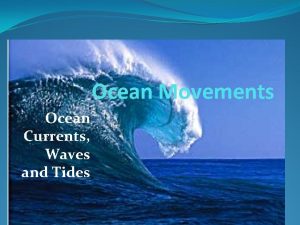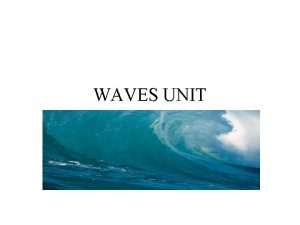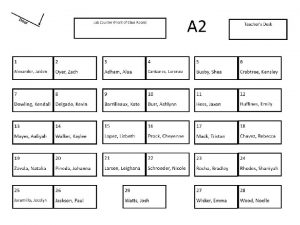Unit 2 Lesson 2 Ocean Waves Copyright Houghton



















- Slides: 19

Unit 2 Lesson 2 Ocean Waves Copyright © Houghton Mifflin Harcourt Publishing Company

Unit 2 Lesson 2 Ocean Waves Catch the Wave What are some properties of a wave? • A wave is any disturbance that transfers energy through matter or empty space. • An ocean wave is a disturbance that transfers energy through ocean water. Copyright © Houghton Mifflin Harcourt Publishing Company

Unit 2 Lesson 2 Ocean Waves What are some properties of a wave? • A wave is made up of two main parts: a crest, which is the highest point of the wave, and a trough, the lowest point of the wave. • The distance between two adjacent wave crests or troughs is a wavelength. • Wave amplitude is half the distance between the crest and the trough. Copyright © Houghton Mifflin Harcourt Publishing Company

Unit 2 Lesson 2 Ocean Waves What are some properties of a wave? • Frequency is the number of waves produced in a given amount of time. • Wave period is a measurement of how much time it takes for a wave to pass a fixed point. It is the inverse of frequency. • Wave speed is how fast a wave travels. To calculate a wave’s speed, multiply its wavelength by its frequency. Copyright © Houghton Mifflin Harcourt Publishing Company

Unit 2 Lesson 2 Ocean Waves What are some properties of a wave? • How could you find the wave speed of this wave? Copyright © Houghton Mifflin Harcourt Publishing Company

Unit 2 Lesson 2 Ocean Waves Surf’s Up! What causes ocean waves? • Ocean waves are a type of wave known as a mechanical wave. Mechanical waves carry energy through matter, such as water. • Most ocean waves form when energy in the atmosphere is transferred to the ocean’s surface. • Wind blows across the water’s surface and transfers energy to the water, and this energy is carried by the wave. Copyright © Houghton Mifflin Harcourt Publishing Company

Unit 2 Lesson 2 Ocean Waves What causes ocean waves? • Ocean waves can also be produced by underwater earthquakes, underwater landslides, and underwater volcanoes. • If a meteorite or an asteroid landed in the ocean, it could displace enough water to cause large waves. Copyright © Houghton Mifflin Harcourt Publishing Company

Unit 2 Lesson 2 Ocean Waves What causes ocean waves? • Explain what is happening in each image below. Copyright © Houghton Mifflin Harcourt Publishing Company

Unit 2 Lesson 2 Ocean Waves What causes ocean waves? • Explain what is happening in each image below Copyright © Houghton Mifflin Harcourt Publishing Company

Unit 2 Lesson 2 Ocean Waves Doing the Wave What happens when a wave moves through the water? • Ocean waves are formed when wind transfers energy to the water. As the energy moves through the water, so do the waves. • The water itself does not travel with the energy. But water at the surface undergoes circular movement. • Wave energy affects surface water to a depth of about half a wavelength. Copyright © Houghton Mifflin Harcourt Publishing Company

Unit 2 Lesson 2 Ocean Waves Watts from Waves • Some of our electrical energy needs could be met by capturing the wave energy along our coastlines. • A wave power generator converts the up-anddown motion of waves into electrical energy. Copyright © Houghton Mifflin Harcourt Publishing Company

Unit 2 Lesson 2 Ocean Waves Watts from Waves • This electrical energy can be carried by a power cable back to shore. Copyright © Houghton Mifflin Harcourt Publishing Company

Unit 2 Lesson 2 Ocean Waves Totally Turbulent What happens when a wave reaches the shore? • When waves reach water shallower than one-half their wavelength, they begin to interact with the ocean floor. • As waves touch the ocean floor, they transfer energy to the ocean floor. • As a result, the water at the bottom of the wave slows down. Copyright © Houghton Mifflin Harcourt Publishing Company

Unit 2 Lesson 2 Ocean Waves What happens when a wave reaches the shore? • As water depth decreases, wave height increases, because more water is forced between wave crests. • The top of the wave travels faster than the bottom of the wave, which drags on the ocean floor. • Eventually, gravity pulls the wave crests down, and they crash onto the shore. These waves that crash onto shore are called breakers. Copyright © Houghton Mifflin Harcourt Publishing Company

Unit 2 Lesson 2 Ocean Waves What happens when a wave reaches the shore? • Most ocean waves reach the shore and transfer their energy to the beach environment. • The energy of the wave and the angle at which the wave hits the shore determine how much energy is transferred. Copyright © Houghton Mifflin Harcourt Publishing Company

Unit 2 Lesson 2 Ocean Waves What happens when a wave reaches the shore? • High-energy waves can quickly erode beaches. Strong waves can even throw boulders and other debris up on the beach. Copyright © Houghton Mifflin Harcourt Publishing Company

Unit 2 Lesson 2 Ocean Waves What is a tsunami? • A tsunami is a series of waves that form when a large volume of ocean water is suddenly moved up or down. • This movement can be caused by earthquakes, volcanic eruptions, landslides, or the impact of a meteorite or asteroid. • When a tsunami approaches land, the waves slow down and get taller as they interact with the ocean floor. Copyright © Houghton Mifflin Harcourt Publishing Company

Unit 2 Lesson 2 Ocean Waves What is a tsunami? • Tsunamis can reach more than 30 meters in height as they slam into the coast, destroying almost everything in their path. • The huge volume of water that crashes onto shore then rushes back into the ocean. • This powerful flow of water, called an undertow, can be as destructive as the tsunami itself. Copyright © Houghton Mifflin Harcourt Publishing Company

Unit 2 Lesson 2 Ocean Waves What is a tsunami? • Describe the sequence of events shown here. Copyright © Houghton Mifflin Harcourt Publishing Company
 Copyright houghton mifflin company
Copyright houghton mifflin company Copyright houghton mifflin company
Copyright houghton mifflin company Copyright houghton mifflin company
Copyright houghton mifflin company Copyright houghton mifflin company
Copyright houghton mifflin company Copyright houghton mifflin company
Copyright houghton mifflin company Divergent plate boundary
Divergent plate boundary Ocean ocean convergent boundary
Ocean ocean convergent boundary Convergent plate boundaries
Convergent plate boundaries Ocean ocean convergent boundary
Ocean ocean convergent boundary Chapter 15 ocean water and ocean life wordwise answer key
Chapter 15 ocean water and ocean life wordwise answer key Sciencechannel.com/activate
Sciencechannel.com/activate Convergent oceanic oceanic plate boundary
Convergent oceanic oceanic plate boundary Blue ocean strategy canvas
Blue ocean strategy canvas Ocean currents waves and tides
Ocean currents waves and tides Similes for the beach
Similes for the beach The phenomenon of diffraction can be understood using *
The phenomenon of diffraction can be understood using * Ocean waves
Ocean waves Ocean waves
Ocean waves Current pattern
Current pattern Breaking waves
Breaking waves
